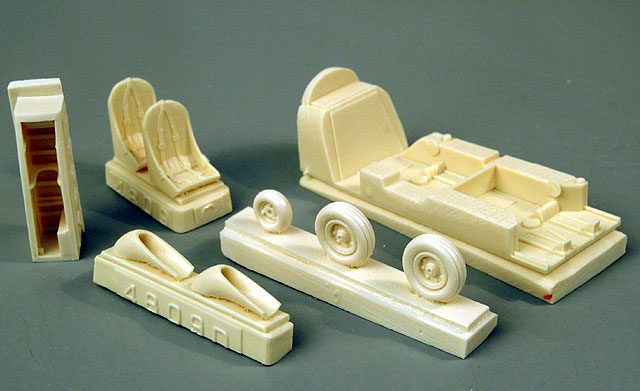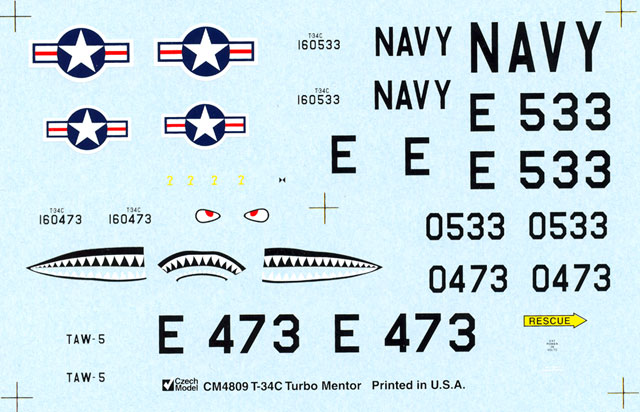|

Czech Model's 1/48
scale T-34C Turbo Mentor is available online from Squadron.com
S
u m m a r y
|
| Catalogue Number: |
CM4808 |
| Scale: |
1/48 |
| Contents and Media: |
51 parts in short-run injected grey styrene;
9 parts in cream-coloured resin; 2 clear parts on a vacform sheet (canopy
and spare); decals for two aircraft. |
| Price: |
USD$24.96
from Squadron.com |
| Review Type: |
FirstLook |
| Advantages: |
Appealing subject; high-quality
plastic; good detail; crisply engraved surface features; effective use of
multi-media. |
| Disadvantages: |
Some flash; shiny surface could use
with some basic preparation; no depiction of wing formation lights. |
| Recommendation: |
Recommended to modellers with some
experience working with short run kits. |
Reviewed by
Brett Green
The T-34 Mentor will be remembered with nostalgia by many US
Naval aviators who undertook their training any time between the mid 1950s and
the present day. The T-34C variant was a significantly modified Mentor airframe
equipped with a Pratt & Whitney turboprop engine. The Turbo Mentor was built
between 1977 and 1990.
Czech Model's 1/48 scale T-34C Turbo Mentor is a welcome
addition to this company's growing range. The kit comprises 51 parts
in grey styrene, 9 parts in cream-coloured resin, two vacform canopies (including
a spare) and decals for two US Navy training aircraft.
The quality of the plastic parts is
high, and surface detail is crisply engraved. The texture of the control
surfaces (pressed metal?) is very nicely depicted.
The plastic is quite itself is quite shiny which, for me, was a
bit off-putting at first. However, there are no sink marks or ejector pins in
visible locations anywhere on the model. The sprue attachment points are quite
restrained too. The trailing edges of the wings and tail surfaces are fairly
thin, but a little sanding will not hurt.
Click the thumbnails below to view
larger images:
Resin parts are supplied for the cockpit tub, seats, resin wheels,
forward wheel well and intakes. These resin parts are very well done - detail is
crisp and my sample displayed no casting imperfections. However, the cockpit tub
and wheel well feature substantial casting blocks that will need to be carefully
removed. Take your time with the seats too - it will be easy to cut through the
bottom of the seat when these blocks are being removed.

A vacform canopy is supplied with a spare in case of disaster.
The canopies are very clear and totally free of distortion.
Engineering is typical of a limited run kit. The wings
mount flat against the fuselage, but the surface area of the join will be quite
large so reinforcement may not be necessary. On the other hand, the tail
surfaces should be reinforced with wire or rod to supplement the locating
dimples. Some small details will need to be supplied by the modeller, such as a
wire axle for the front wheel. Also, typical of limited run kits, there are no locating pins
so care should be taken to align the parts accurately.
Instructions are called out over ten
construction steps on four letter-sized pages. These instructions seem to be
quite adequate.

Markings for two US Navy aircraft in white and orange are
supplied on the decal sheet.
Czech Model's 1/48 scale T-34C Turbo Mentor lives up to the
improving standards of this company's most recent releases.
Keep in mind that this model is not a "shake and bake"
mainstream kit. As a limited run model, it will require a little extra time in preparation and assembly,
but should deliver a good looking result when finished. Anyone with
some experience of limited-run kits should be capable of completing this kit
without much trouble.
Now I only hope that some decal company comes out with markings
for Latin American camouflaged ground-attack Turbo Mentors!
Recommended.
Thanks to Squadron.com for the review sample.
Review and Images Copyright © 2002 by Brett
Green
Page Created 21 November, 2002
Last updated 22 July, 2003
Back to HyperScale Main Page
Back to Reviews Page
|
Home | What's
New | Features
| Gallery |
Reviews | Reference
| Forum
| Search